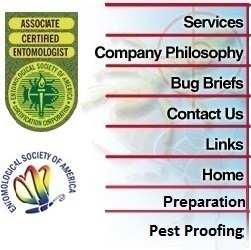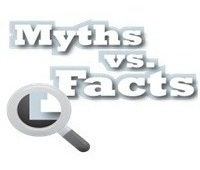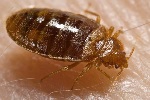
|
 If you haven't had enough of bed bugs after reading this page this link offers one of the most comprehensive detail we have found. |
|
Home remedies and do-it-yourself products A recent article in Science News gloomily summarized some of the most current information about DIY bed bug control, based on papers presented at the annual conference of the ESA. Rubbing alcohol, bug bombs and other products just don't work that well. And some products, like ultrasonic repellers, are completely ineffective. Science News reported that rubbing alcohol killed only about half of the bed bugs that were sprayed directly. Bed bugs confined in a plastic bag for seven days with mothballs (a much higher exposure than you would expect in a clothes closet or storage chest) had about the same survival rate. Also, applications of Diatomaceous earth provided inconsistent, or only marginal, bed bug control when used by itself, without sprays or other supplemental treatments. Diatomaceous earth is an abrasive that scrapes away some of the protective waxes that keep bed bugs from drying out (desiccating) in the dry indoor environments of homes. Many insects compensate for water leakage caused by desiccant dusts by taking in more water from feeding. Perhaps bed bugs in the field are able to compensate for moisture loss by taking in more moisture through more blood feeding. Not a pleasant thought if you're the one being fed on. (From Dr. Michael Merchant's blog Insects in the City) |
How we treat for Bed Bugs We follow an integrated pest management approach to treatment. [ How does IPM work? ] We will use combinations of steam, chemicals, passive monitors and traps, active monitors and traps and exclusionary strategies. The work we do requires preparation on the customers part and cooperation after treatment. Doing treatment this way is safe, effective and reduces the cost of treatment significantly but does require help from the customer. This type of approach is cost effective in cases of mild to moderate infestation. In cases of severe infestation or significant clutter, or when the customer is unable to prepare, then heat treatment (which is effective but significantly more expensive) would be the only reasonable solution and we will be happy to refer you to a reliable company that has experience. Review the sections below to decide if this approach is right for you and ways to prevent problems in the future. Read Straight Talk |
|
Preparation for treatment Bed Bug treatment program procedures: Treatment is centered around 2 strategies. The first is a thorough pest control treatment with non-repellant residual chemicals. The second is to use exclusionary measures, traps and monitors to prevent any insects that were in inaccessible areas from gaining access to the resident and reestablishing a population. Both are critical to success. Bed bugs are primarily nocturnal so treatment is centered around those areas where people are when it is dark. However other areas are also treated so these procedures apply to the entire dwelling. The customer must obtain both mattress & box spring encasements which prevent any bed bugs from re-infesting those items. Those can be obtained online or locally. They should be sized to fit snugly. Protect-A-Bed and SafeRest are notable brands. Prices for a bed set ( mattress and box springs ) is about $100. If the current bed set is in good condition, leave it in the room without sheets. If the current bed set has cuts, rips or holes it should be removed and replaced. The encasements should be put on the bed set before treatment. Pillows generally do not need encasements as they can be put in a dryer to kill any bed bugs. In addition, the bed set must be on a frame and not sitting on the floor. If sofas have been slept on and especially if they are in poor condition, consider discarding them. Just like a bad mattress it is impossible to get insects out of a tattered and torn sofa. Heat chambers would work but the cost to do so would be more than the cost of a tattered piece of furniture. Prior to treatment EVERYTHING has to be taken off the floor except furniture. Do not pile things up on beds, sofas or furniture. Furniture should be moved away from the walls to the center of the room. During the treatment process the clothing and bedding needs to be washed and dried at a laundry and brought back in new plastic bags. If the laundry is already clean then it just needs to be run thru the dryer. Toys and small items are best put in closed bins or plastic bags. In some cases the dressers and night stands need to be emptied and they will be treated. You should plan on being gone for most of the day since the chemicals need to be dry before you re-enter. On return, make sure the bed is on a frame and is several inches from the wall with no electrical cords running between the bed and the wall. There should be no bed skirt or other bedding touching the floor. If climb up interceptors are installed make sure they stay in place under the frame. Encasements need to remain on the bedding. If they get cuts or openings they should be replaced. There is no magic formula for treating bed bugs. Clutter is their best friend both because it gives them places to hide and because it prevents us from treating some areas, which then means the treatment will be unsuccessful. All the preparation above has to be done for treatment to be successful and it is senseless to treat if it is not. |
Prevention
Here's an interesting believe it or not! Bed bugs have a fearsome enemy: the bean plant. Traditionally, Eastern Europeans filled their bedrooms with bean plant leaves, which trap bed bugs with tiny hook-like hairs, then burned the leaves the next morning. Inspired by this custom, scientists are studying bean plants’ ability to deter bed bugs in modern-day societies, The leaves’ success inspired scientists to try to create synthetic bed bug traps modeled after the bean plant leaves using epoxies. But the synthetic traps did not work as well as the natural ones: it took the bugs 39 steps on average to get stuck. Even then, the synthetic hairs did not pierce the bugs’ carapaces, and they usually escaped. The scientists are now refining their design to improve the device’s performance. University of California, Irvine, biologist Catherine Loudon and colleagues looked at bed bugs trapped on bean plants using video and an electron microscope, and found that the leaves were covered in small hooked hairs, which pierced the thin areas in the insects’ carapaces near their joints. On average, the bugs were trapped after just six steps on the plants. |
Discussion of Heat Treatments Flour mills and food processing plants in the United States and Canada now routinely incorporate heat treatments into their pest control strategy. In fact, some North American facilities have used heat treatments to manage insect pest populations for more than 75 years. The process involves heating all or part of a facility to 120ºF - 140ºF for 20 to 36 hours. Treating residences with heat also has been around for a while and is really getting a lot of attention since bed bugs have come back on the scene. The process can be quite expensive depending upon how much preparation is required. Heat is pumped into a structure through ducts or with portable machines to raise room temperatures for a set time. Here are a few of my issues with heat treatments. If you have a problem in one or two rooms of a structure and you wish to treat those rooms only, how do you prevent the pests from migrating from those rooms as temperatures rise? The insects won't stick around while the room temperatures rise. If it takes professional food processing companies over twenty hours to kill their insects, how does an hour or two of high temperatures kill all of the insects hiding deep inside a couch or inside walls? To be fair, some companies do adhere to the guidelines. Just keep in mind that heat has to permeate through layers of fabric and cushion or through drywall and insulation to be effective. A "whole house" treatment can be expensive and disruptive. A small apartment treatment may cost in the range of $1,200 and with preparation, take up to eight hours. You have to remove perishable foods and goods like candles and sensitive electronics. Plasma TV's, pianos, and computers can be at risk. I would also ask a lot of questions about how the heat affects painted walls and wall paper. Some companies reduce these risks by holding temps below 120 degrees but several studies show bed bugs require higher temperatures for several hours in order to be reasonably successful at killing all stages. There have been reports that many museums have stopped using heat treatments because of damage to furniture and specimens. In many cases drawers containing insect and other specimens shrank, cracked and became distorted. The heat treatment side effects were due to moisture loss and shrinkage of the wood making the treatment unacceptable. Heat will kill insects, for sure. There are easier and less expensive methods to achieve the same results in many cases. I think using some low-toxicity pesticides and exclusionary steps would be a better alternative in cases of minor to moderate infestation. In cases of substantial infestation or where a lot of "clutter" exists, heat might be the appropriate solution. |
|
We are as savvy as an old dog but as eager as a puppy to serve you ! |

